Introduction
I recently won a computer terminal at a local auction. I bid on it because I had been hoping to find a vintage computer terminal for a while, so I could connect it to my Altair-Duino or PiDP-11 kits. This one looked cool, I thought I would not win the auction, and then I did!1
See also:
- The TeleVideo TVI-912 terminal - Part 2, where I fix the video control board and memory and manage to ge the terminal working
- The TeleVideo TVI-912 terminal - Part 3, where I complete the restoration of the terminal

Esthetically, I find the terminal good-looking with its curved body. It’s very different from the iconic DEC VT100, which is of the same era, but there is nothing wrong with liking different styles.2
This instance bears the marking “TeleVideo TVI-912”, which is of course the brand and model number. I didn’t know anything about TeleVideo terminals before this acquisition, but that changed quickly!
Background
TeleVideo the company
Wikipedia has a page about TeleVideo. The company was based in San Jose, California3, and made terminals until about 2011 when it definitely folded. It seems that the company was founded in 1975, although this reference mentions that “TeleVideo Systems, Inc. was born in March of 1979”. This other reference mentions 1975, while the official web site, which is only a leftover page, mentions “35 years in business” as of 2011, which points to a date closer to 1975 than 1979. It might be that the company started in 1975, but was renamed or reincorporated in the following years.
Dating and pricing of the 912 model
The TeleVideo TVI-912 was one of the first models made by the company. It came out in 1978 or 1979:
This terminals wiki page mentions 1978 and supports this by referencing a Computerworld article announcing the device from September 4, 1978, which I cropped below:
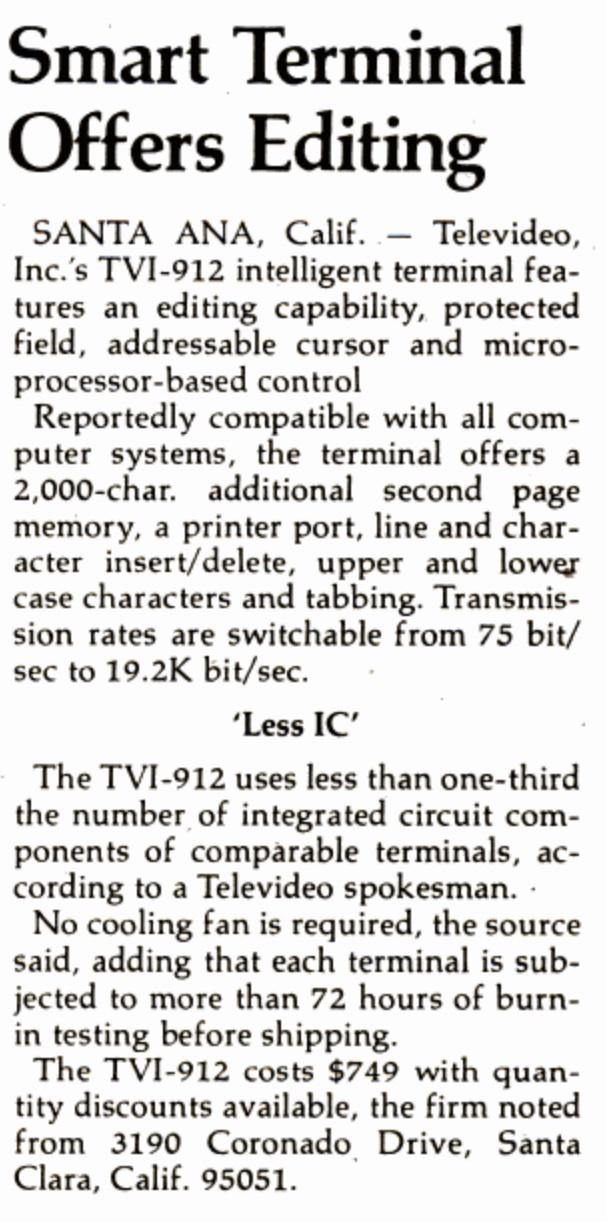
1978 Computerworld article - This vt100.net page mentions 1979.
This page also mentions 1979:
The TVI-912, introduced in 1979, the same year TeleVideo was founded, was one of TeleVideo’s earliest terminals, preceded only by the TVI-910. It supports a 96-character ASCII upper and lower case alphabet, displays 24 80-character lines on screen, and weighs in at 30 lbs. It supports 9 data rates on RS232 serial interfaces, ranging from 75 to 9600 baud (bits/second) with half-duplex and full-duplex conversation and block transfer modes.
- The manuals I found (see below) bear a copyright of 1979 at the earliest.
- The control board of my instance (see further below) shows a date of 1979 (2-79) as revision date.
- The control board also shows a copyright of 1978 for the ROMs.
Based on the article referenced above it is certain that the device was announced in late 1978, but it might not have been really on the market until 1979.
The price announced was $749, which translates into $3,580 in 2023. In other words this would be the price of a fairly high-end personal computer today, like a top of the line 16-inch Apple MacBook Pro.
Documentation
There is a lot of documentation about this terminal online. The following sections list what I found.
TeleVideo Operators Reference Handbook (1979)
This is for the following models:
- TVI-912B and TVI-920B
- TVI-912C and TVI-920C
This manual has 36 pages including covers, and a copyright date of 1979. You can find it on Archive.org.
There are a couple of versions, if not more, of this manual.

Operating instructions (1979)
This is for the following models:
- Model 912
- Model 920
This has exactly the same table of contents as the previous manual, and is also dated 1979, but it has only 19 pages. I haven’t compared the content with the other manual in detail.
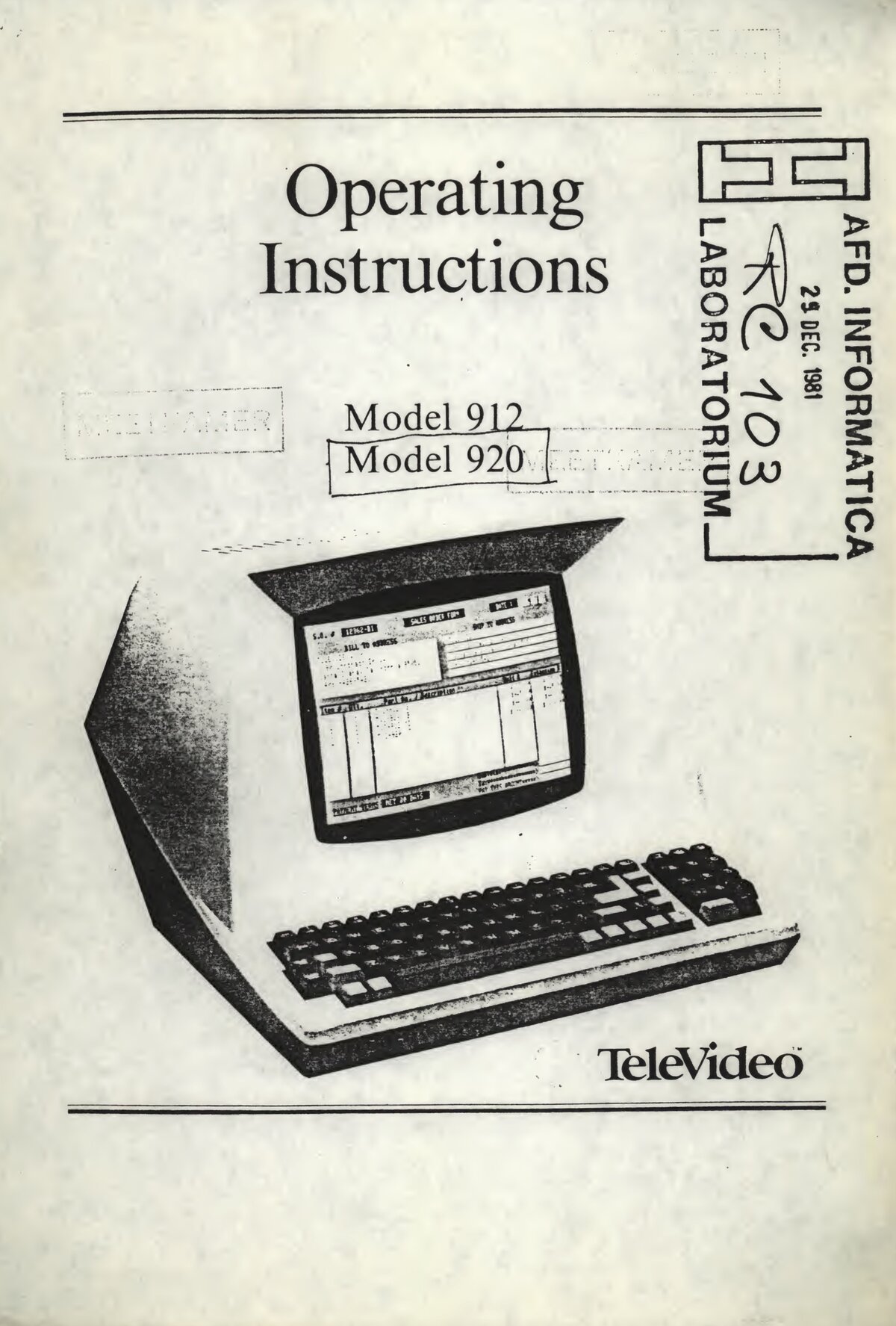
TeleVideo Terminal Maintenance Training Manual (March 1983)
This manual has 558 pages! To be fair, 98 of those pages are manufacturer spec sheets for components. This appears to cover all the terminal models up to the March 1983 date of publication: 910, 912, 920, 925, 950, and 970. It includes full schematics of the terminals!
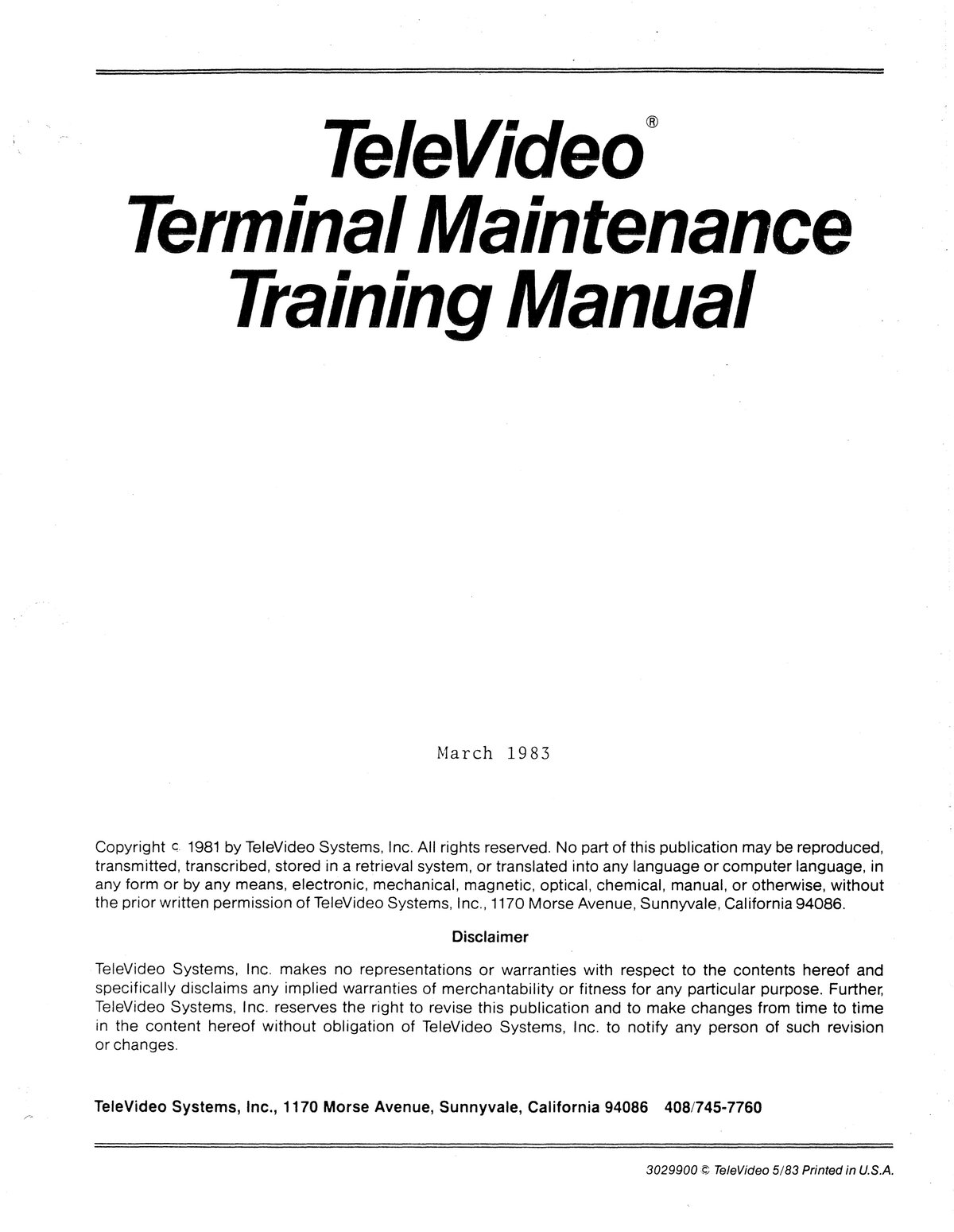
Here is one of the pages of the schematics for the 912, showing the microcontroller:
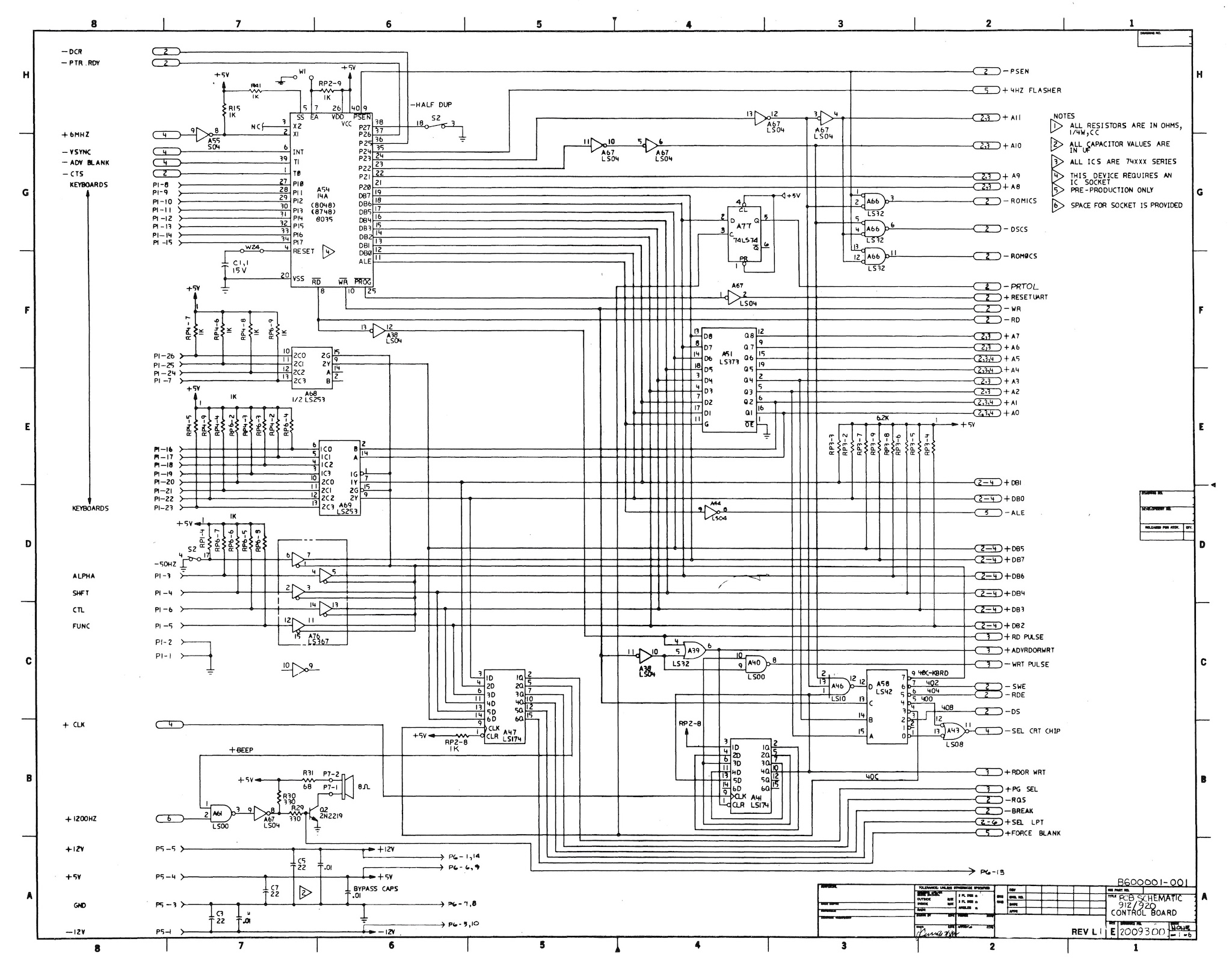
“The Value Leaders” marketing brochure
This is an 8-page marketing brochure, where we learn about some features of the terminals up to model 950, including some that requires digging intom including:
- “true block mode”
- “typewriter tabbing”
Now this makes me want to find a 925 or 950 terminal! Look at these beauties!
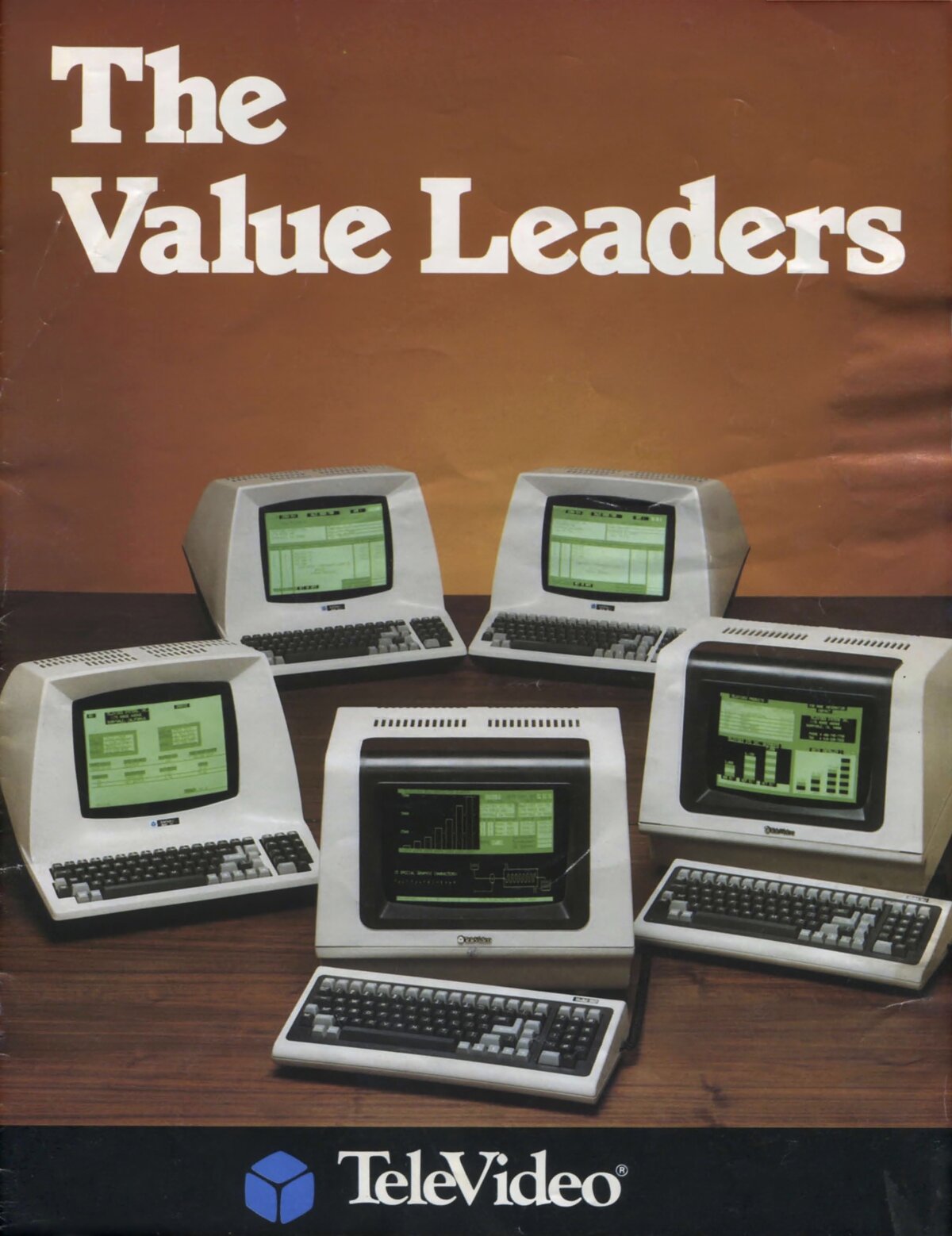
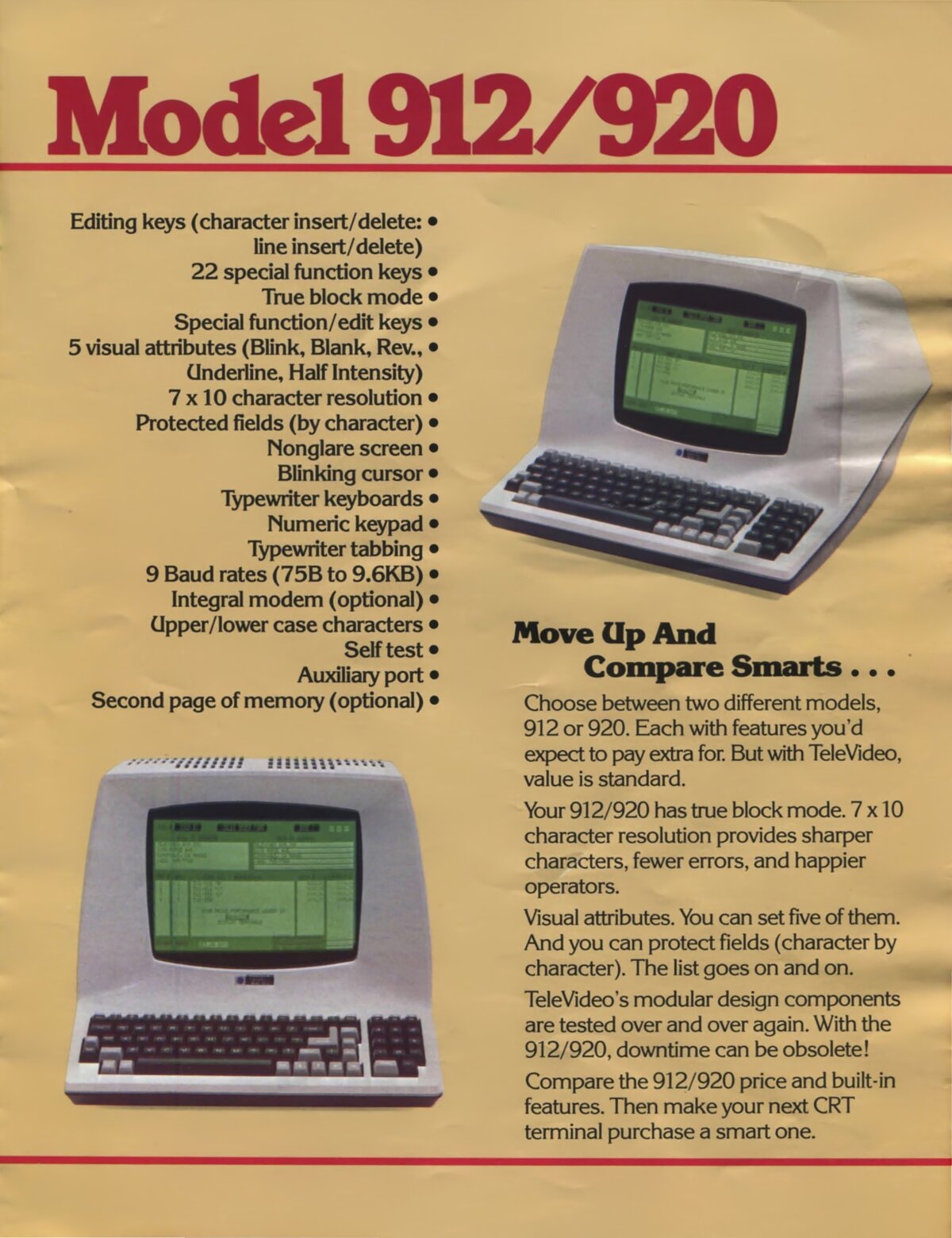
“Compare Smarts. Compare Prices.” marketing brochure
This is a 6-page marketing brochure specifically about the 912 and 920 models. It is dated 1980. It has a lot of information about the terminals, including a comparison between the 912 and the 920 (variants B and C).
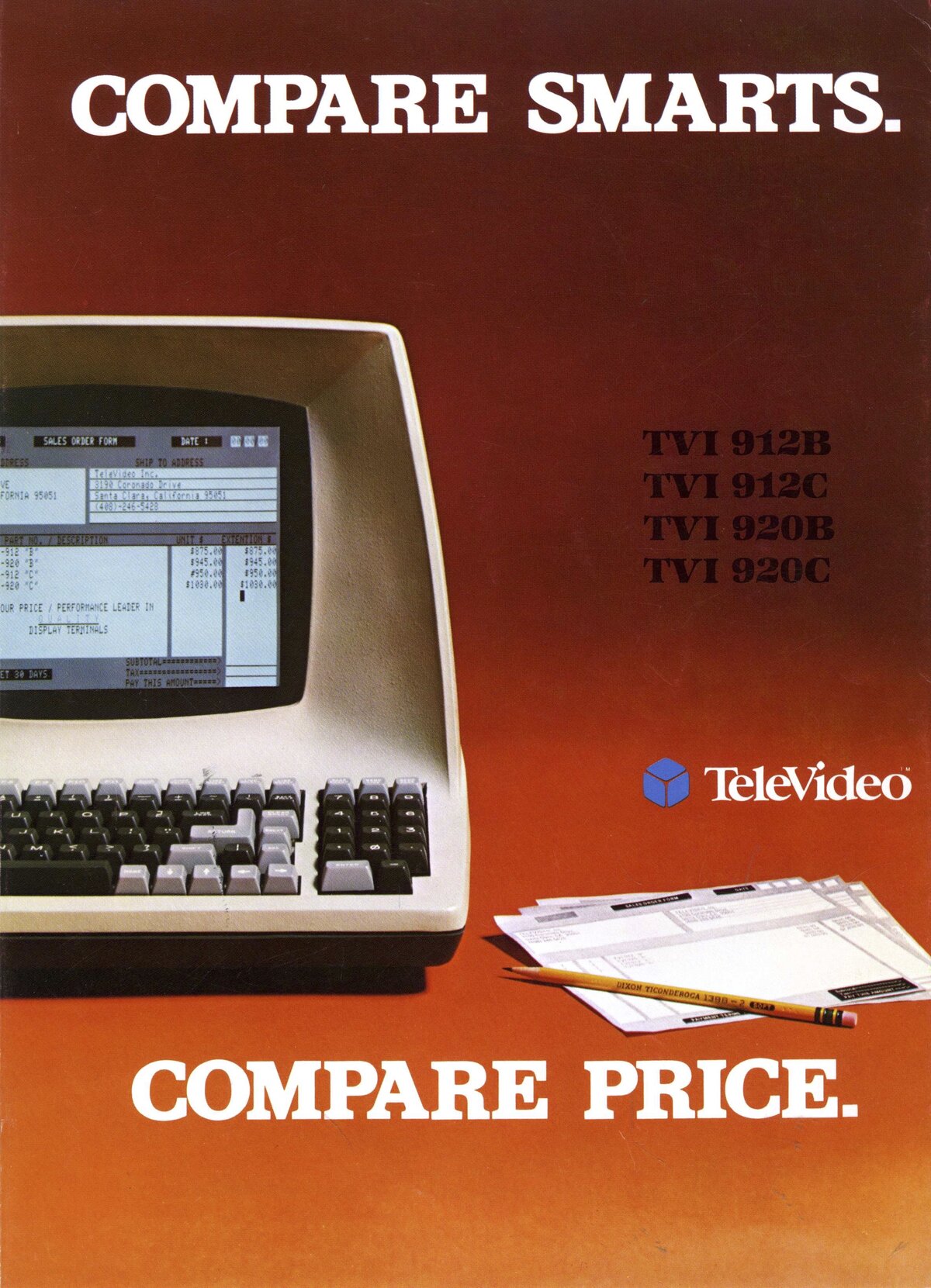
Other resources
There is a video series on YouTube, mostly about cleaning a working TeleVideo 912. In particular, the author completely disassembles the keyboard, including desoldering all the key switches for in-depth cleaning. I wouldn’t have considered going that far without seeing this video.
Turning it on
I took the risk of turning on the terminal. The good news is that it beeped right away! The bad news is that the screen only showed some indication of life over a vertical area in the middle of the screen. This told me that:
- maybe the control board was working, at least to some degree
- but the electronics controlling the CRT might have issues
Later, I also tried CTRL-G, which is the code for the “BEL” character, which is supposed to beep, but nothing happened. However, I think I might need to configure the RS-232 interface to loop back for that to have any chance to work.
Can the terminal be fixed? That’s what I hope to figure out eventually.
Opening it up
I opened the terminal: two screws in the front unlock the top of the terminal, which then swivels on its hinges in the back.
The CRT remains in the top case, with the terminal’s power supply on the left, and the video control board on the right. The CRT is braced by a rusty spring:

I took a look at the control board. It is a beautiful large board, but it looked very dirty, with signs of corrosion.

Here is a close-up of the main video chip, before any cleaning:

I blew some air inside the case and on the board. I also did a first pass at cleaning the board with isopropyl alcohol. There was no change in behavior after that, unsurprisingly. But I took more detailed pictures of the terminal. Here is the terminal’s two parts:

Here is the back of the terminal. The RS-232 port is visible, as well as configuration DIP switches, a contrast button, the power button, and a fuse. I believe that there should be a cover over the connector area, and if so it is missing. Instances of the terminal could have a printer port as well, but this one doesn’t have it. Some of the labels had fallen off, but they were stored in a small ziploc bag attached to the terminal.

The keyboard of this 912 terminal has 84 keys in the “teletype” layout. Documentation shows that there were two main layout options:
- “teletype” layout, for models “B” (912B)
- “typewriter” layout, for models “C” (912C)


These options might not have been available from the start. Indeed, my terminal doesn’t show a “B” or “C” suffix.
Model 920 was identical to the 912 except that it had, in addition, function keys, edit keys, and transmission keys. It, too, came in a “B” or “C” version matching the “teletype” or “typewriter” layouts.

The board looks nicer after a basic cleaning.

I recognized the video output and power supply input on the board. I disconnected both, and measured the voltage on the input connector, with values close to:
- -12 V
- +5 V
- +12 V
This means the power supply is in decent shape. Here is a picture of it, attached to the upper part of the case:

The other side of the upper case consists of the video control board:

I note that the terminal’s serial number appears in multiple places, and it is consistent: 79061208. Can we infer from that series of digits a production date of June 1979? Or week 6 of 1979? It would make sense! Comparing with serial numbers of other similar terminals could help validating the format.
The serial appears:
- on the back of the device
- on the CRT
- on the power supply
- on the video control board
The main control board
After cleaning the board an the main ICs, I looked up the references of the main chips, and found the following (also confirmed by the schematics):
| Chip | Description |
|---|---|
| Intel 8035 | 8-bit MCU (microcontroller unit) |
| SMC CRT5027 | CRT Video Timer and Controller VTAC |
| SMC COM2502 | UART |
| 2 × Intel 2111A | 256 × 4 SRAM |
| A3 | 2KB ROM (probably the character ROM) |
| A49 | 4 KB ROM |
| A50 | ROM |
| 4 × TMS4045 | 1 K × 4 SRAM |
So the terminal has 256 bytes of SRAM for the program, with 64 bytes of internal RAM as well in the 8035, for a total of 320 bytes of RAM. That’s not much to work with!
UPDATE 2023-05-12: The ROMs have marking that could be dates:
- the PCB itself says © 1978 next to each of the two main ROMs
- ROM 13: “7849” which could be week 49 of 1978 (so December 1978)
- ROM A49: “7913” which could be week 13 of 1979 (late March 1979)
- ROM A50: “7908” which could be week 8 of 1979 (February 1979)
UPDATE 2023-05-11: In addition, there are 4 × TMS4045 chips, mounted on sockets, for a total of 2 KB of SRAM for the display. This makes sense as 80 columns × 24 lines = 1920 characters, or just short of 2 KB. Another optional bank of 4 chips is available, but unpopulated on this board. This can add support for a second page, per the documentation.
The rest of the chips consists mainly of 7400-series TTL chips. In the 1978 Computerworld article announcing the terminal, there was a claim that the terminal used “one-third the number of integrated circuit components of comparable terminals.” How many ICs were present in the VT100, for example?
I annotated the picture of the board with what I found.

The CRT chip, in particular, is quite beautiful, although it too shows signs of corrosion. On a couple of pictures I found online of the 912/920 board, the chip is a regular black plastic package. Here we have what is probably a ceramic package, with golden pins and a golden cover (but then how is it that it appears corroded?). This might be an earlier version of the chip.

It’s interesting that the terminal uses a fairly simple microcontroller. I thought it might have used a Z80 or similar microprocessor, but apparently a much simpler MCU was enough to drive the system. The DEC VT100, for comparison, used an Intel 8080 CPU.

Reading up on the Intel MCS-48 family of microcontrollers, it turns out that these were often used in keyboards, including the original IBM PC keyboard (which, of course, came out after this terminal, in 1981). A Philips derivative was used in Philips’s first CD player, the CD-100. In short, this was a very popular microcontroller family.
The 8035 is a ROM-less version of the microcontroller: there is no mask ROM or EPROM on the chip, and the ROM has to be external, as is clearly the case with the TeleVideo 912. An Intel manual is available (396 pages), dated July 1978:

Here is a picture of the main ROMs and the UART:

I found that there are dumps of ROMs online, although I don’t know if they match my terminal exactly. It could be interesting to read and reverse-engineer the code! The third ROM (actually the first one, called A3) is a character ROM, I think - that is, a ROM containing the bitmaps (7x10, from the marketing brochures) of the characters that can be displayed on the screen.
Next steps
The goal is to figure out what’s wrong with the terminal. I think the next step consists in hooking up an oscilloscope and figure out what kind of signals we are getting at various points on the board, in particular the video output. This should allow us to determine, first, whether the issue is with the CRT board or the control board (it could be both!). I wouldn’t be surprised if the terminal has multiple issues given the corrosion that is visible.
A quick scan of the service manual shows some troubleshooting procedures, and indicates that a particular transistor is responsible for the horizontal scan. That will be a place to probe.
See also
- The TeleVideo TVI-912 terminal - Part 2
- The TeleVideo TVI-912 terminal - Part 3
- Photo album: Televideo TVI-912 terminal (1979) - Part 1
- Photo album: Televideo TVI-912 terminal (1979) - Part 2
- Photo album: TeleVideo TVI-912 (1979) - Restored
To be fair, I was the only bider on this item. and it turned out that, with that terminal, came a CompuPro System 8/16, and that was a great surprise. But that’s story for later. ↩
I’d love to find a VT100 for a reasonable price, although I am not particularly hopeful. ↩
Although addresses in Sunnyvale and Santa Clara also appear in the documentation, indicating that the firm moved during its lifetime. ↩

Comments powered by Disqus.